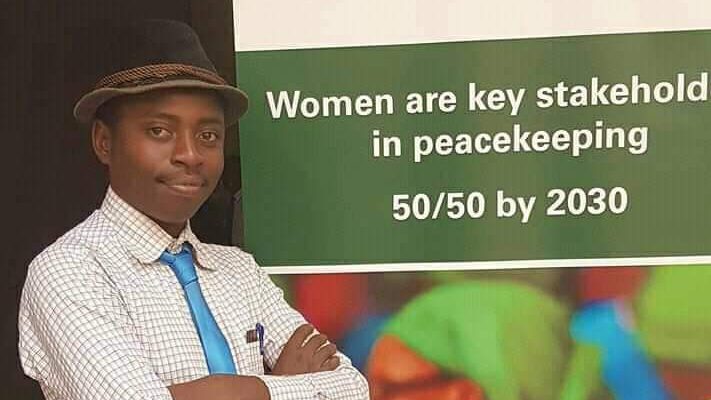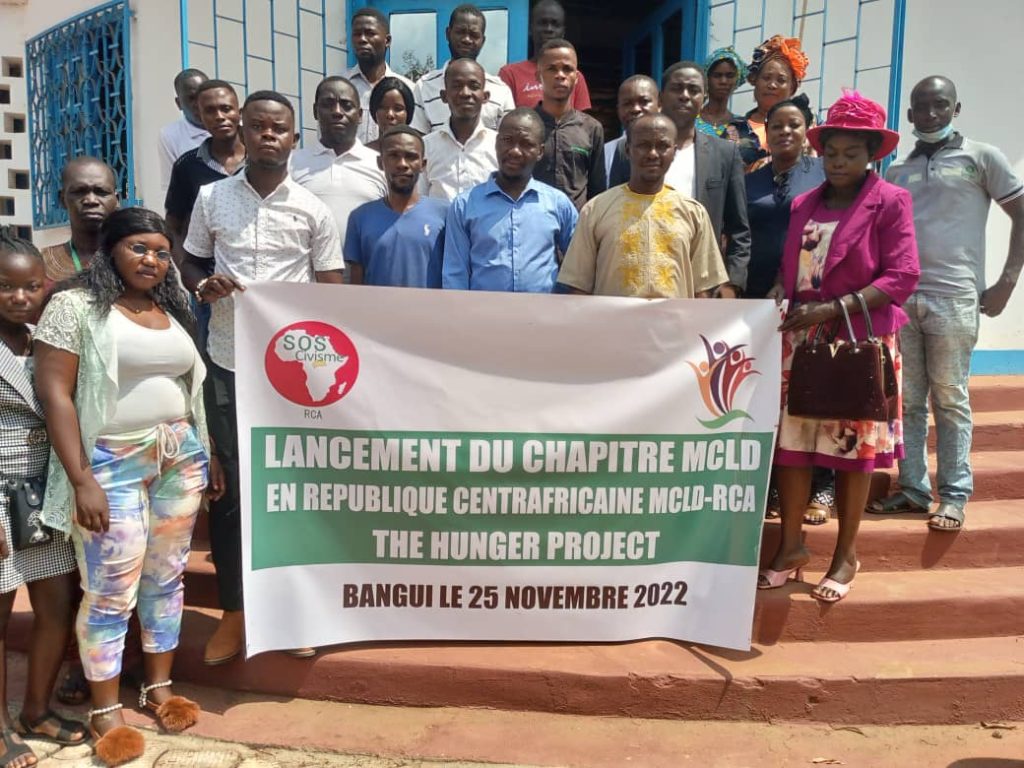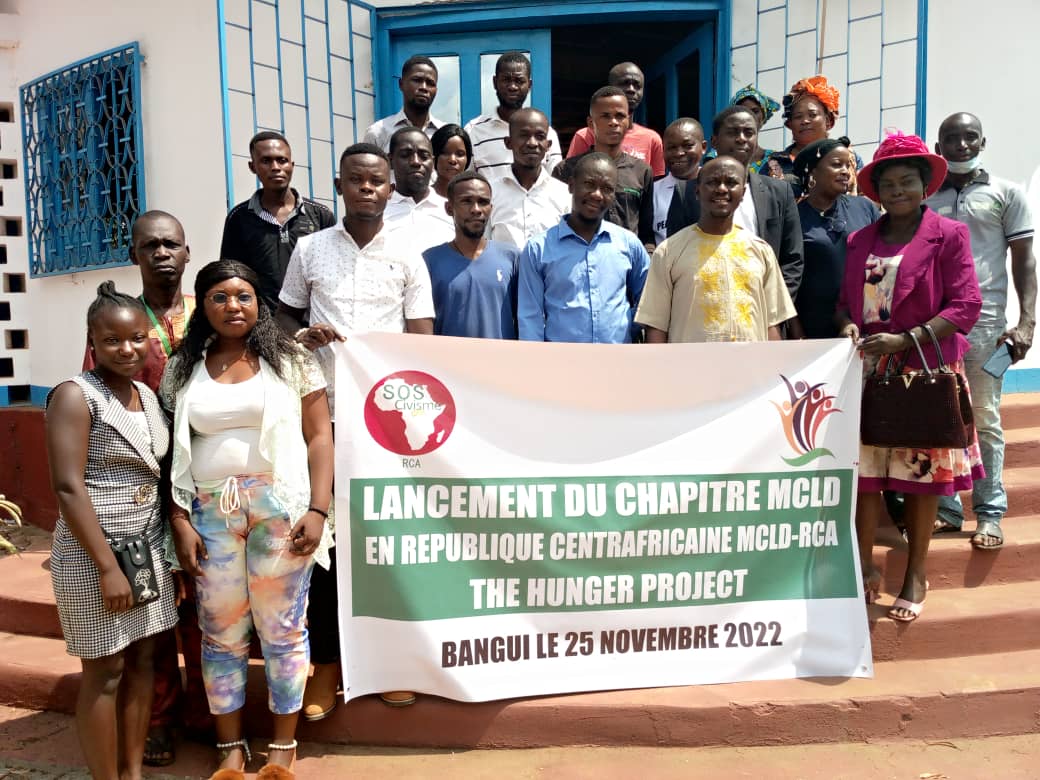November 25, 2022 — MCLD is proud to announce the formal launching of its newest national association!
Report of the launch of the MCLD Central African Republic Chapter
Bangui, November 25, 2022
Introduction
On November 25, 2022 under the leadership of the Organization SOS CIVISME RCA with funding from the HUNGER Project, Central African civil society organizations officially launched the MCLD chapter in CAR, the launch generally and without distinction involves organizations of civil society working in various areas identified on the Central African territory. Since the recent military-political crisis in the CAR, several mechanisms aimed at promoting the return of peace have been developed by national and international organizations and local associations. Among these methods or mechanisms initiated, the question of the sustainability of humanitarian and development projects remains a priority challenge to really put our communities at the epicenter of these actions.
The main objective is to bring together Civil Society Organizations operating at the national and community levels, with an emphasis on capacity building and the transfer of inter-organizational skills to promote integrated community development.
The Central African Republic (CAR) continues to face political instability, conflict and insecurity, limited human and financial resources of state institutions, inadequate socio-economic and infrastructural conditions for reconstruction and development, and to an ongoing humanitarian crisis. Although there is notable progress and efforts by the government and international partners towards stabilization, recovery and peacebuilding, challenges remain. The numerical importance of young people and women (70% of the total population) constitutes a very important force if the potentials within them can be unleashed. Unfortunately, young people and women are under pressure that prevents it from contributing effectively to the process of rebuilding the country. It is therefore necessary to put in place effective strategies that take into account the differentiated needs of men and women and that allow the disaggregation by gender of all development indicators in the country’s policies, programs and budgets. Indeed, despite her remarkable contribution to the development of the country, several factors disadvantage Central African women in political, social, cultural, economic and employment terms. The Central African Republic’s peacebuilding and recovery journey is outlined in the National Recovery and Peacebuilding Plan (RCPCA), to which the United Nations Development Framework is aligned and supports the achievement of the set goals. . This initiative responds to the various pillars of the RCPCA.
Some Concepts of Good Governance
Good governance is defined as the way in which power is exercised to manage national economic and social resources devoted to development. Rule of law is hierarchical legal rules. Independent justice, rule of law. A rule of law is a state in which the law is binding on everyone, including the state itself. It is also a state in which there is a hierarchy of legal norms and an independent judiciary. The strengthening of civil society has gradually become one of the major processes of development and the concept of capacity building.
Efficiency and quality of projects in the Central African Republic
The project coordination and implementation strategy around the same results framework has significantly strengthened the implementation and monitoring of the various programs in the Central African Republic. Project efficiency was limited by administrative delays which caused delays in the execution of partnership contracts with implementing partners.
Economic Context
Undeniable efforts have been made in terms of education and socio-economic integration of women, but it must be recognized that in most cases, the fate of women to date remains the subject of legitimate concerns.
- Inequality of training in relation to employment: The low rate of education for girls automatically restricts their access to quality vocational training. In a country where the labor market remains symbolic, the opportunity for young people and women to find fulfilling work that can provide them with economic independence becomes uncertain. Faced with these initial handicaps, he only has the choice to devote himself to domestic and rural work or to “do business”, which does not mean much in economic terms either.
ques, because this term generally covers a dive into the informal and into survival activities without real accumulation of capital.
- Income inequality: The majority of Central Africans live in rural areas, where poverty is rampant. Thus, in rural areas, 81% of women, compared to 69% of men, are affected by poverty. Consequently, women run a greater risk of dying between the ages of 15 and 49, due to maternal mortality linked to complications of childbirth among poor women and early marriages, although they have a longer average life expectancy. higher than that of men.
- Low incomes: Women living in rural areas have practically no monetary income worthy of the name, the bulk of their activities being devoted to the supply of products and services necessary for the survival of the family. The small activities of resale of agricultural and livestock products are used to finance the family’s market needs. In urban and peri-urban areas, the woman has de facto become the breadwinner of the family, when the man faced with unemployment no longer fulfills his traditional role. Despite this, women cannot easily access bank loans due to lack of collateral, which also prevents them from improving or developing agricultural activities and obtaining cash income.
Nowadays, there are unfortunately no reliable statistical tools to measure the contribution of women and young people to the production of national wealth and therefore to quantify their contribution to the constitution of GDP. However, due to the country’s difficult economic situation, Central African women and young people have moved very quickly from the status of “forgotten ants” to that of increasingly important economic agents. They are present in all productive sectors of the economy and dominate the informal economy. It is they who actually support the largest part of the population through small businesses selling food products, basic necessities, cheap clothes, etc. All this economic activity is largely financed with equity, without significant bank loans. Women and young people organize forms of associative financial solidarity through tontines (Kérémba) and various forms of savings and credit structures, but there is the problem of significant and structured lines of refinancing.
In 2018, the Central African Republic was ranked 188th (out of 189 countries) in terms of human development[1]. The unemployment rate is high (6.5% in 2018 according to estimates by the International Labor Organization (ILO) and the majority of the population lives in poverty[2]. The security crisis that the country has experienced in recent years has aggravated social inequalities as well as the lack of basic social infrastructure The 2018 budget includes several fiscal policy measures aimed at generating an additional 0.4% of GDP[3] (such as the application of the common external tariffs of the Community Economy of the States of Central Africa -CEMAC on imports, and the repeal of derogations, the increase in export taxes for timber, diamonds and gold; the increase in excise duties on alcoholic beverages, cigarettes and other beverages; and the introduction of a motor vehicle tax) The new budget also targets a domestic income-to-GDP ratio of 9.6%, current primary expenditure of 9.7 % and capital expenditure f financed at 1.3% by the national income.
Faced with these economic and social situations, the civil society organizations of the Central African Republic have decided to launch the Chapter of the Movement Led by the communities in the CAR in order to promote the implementation of the dynamism of the fight against food insecurity. and poverty by investing more in our communities.
Conclusion
The MCLD RCA chapter has brought together more than a dozen civil society organizations from the Central African Republic and intends to expand it gradually to other entities interested in joining the Community-Driven Movement in a holistic way by promoting community development.
Recommendations
- Institutional and material support for the MCLD RCA Chapter
- Support for an experience sharing travel session between MCLD Benin and MCLD RCA chapters on good practices
- Support for resource mobilization
- Advocacy training
- Implementation of The Hunger Project for the Central African Republic to fight against famine and poverty
- Provide support to develop a partnership between the MCLD RCA and other international organizations members of the Movement at the global level
- Support for capacity building sessions
- cities of civil society organizations
- Develop a national action plan on Community Development
- Our communities are the strengths of all development initiatives that we must undertake, whether in a context of conflict or in times of stability.
[1] IMF – World Economic – December 2019
[2] ILO, 2019. CAR Socioeconomic Indicators Report, 2019
[3]World Bank: Report on the economic situation of CAR – Latest available data December 2019.
Latest Chapter News
-
Emmanuel Singa – l’Engagement Communautaire et de Mobilisation Sociale

Emmanuel Singa works on issues of community engagement and social mobilization that enable the community to take local initiatives for development while building on available local resources. In this month’s article, Emmanuel unpacks his vision for MCLD-RCA and his conception of community-led development.
Annex pictures






